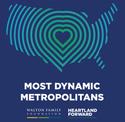China stands as the primary exhibit of twenty-first-century urbanism. At a time when elite cities in the West barely manage to grow in population, Chinese cities have emerged out of virtually nothing, as hundreds of millions of people have moved from farm to city. read more »
Geography
The Midwest’s Small Suburbs
I’ve been examining data lately, revisiting a topic I’m mentioned in the past, namely the smaller sizes of suburbs in Midwest cities compared to other parts of the country. This applies to much of the US east of the Mississippi as well.
West of that river, there are a number of states and regions where there are large suburbs, some of them ranking among the largest municipalities in the country. For example, here are the ten largest suburbs of Dallas-Ft.Worth: read more »
- Login to post comments
As United States Divide, the Green New Deal Could Be Democrats’ Undoing in 2020
If next year’s election is a referendum on Donald Trump, you can hand power to the Democrats now. But fortunately for the president, and the Republican Party, politics remains more about interests than personalities.
More than by cultural memes touching on race, gender, and even taste, the United States are divided by where we live and how we make our living. America, after all, is a vast country and its remarkable economic diversity is what makes it so dynamic and capable against all competitors. read more »
- Login to post comments
The Shanghai to Changzhou Adjacent Urban Areas (with a Photographic Tour)
After China’s Guangzhou-Hong Kong adjacent urban areas in the Pearl River Delta (see: “Ultimate City: The Guangdong-Hong Kong-Macao Greater Bay Area”), the second most expansive urbanization in the world stretches from Shanghai to Changzhou in China. read more »
- Login to post comments
New Metropolitan Rankings Show Knowledge-Based Industries and Entrepreneurship Drive Success
Today, the Walton Family Foundation released “The Most Dynamic Metropolitans,” new research ranking the economic performance of metropolitan areas in the Heartland and across the country. The study demonstrates that a knowledge-based economy spurs economic growth in metropolises across the United States. Metro areas with knowledge-based economies ranked higher than cities that have yet to make much-needed investments in technology, education, entrepreneurship and commercialization. read more »
- Login to post comments
Obstacle Course
I was in Atlanta last month and was encouraged to poke around by the people who invited me. For my entire life the greater Atlanta metroplex has grown in population, geographic size, economic importance, and cultural relevance. As the locals like to remind everyone, Hartsfield-Jackson is the busiest airport in North America. Half the people I went to school with in New Jersey in the 70s and 80s migrated to places like Atlanta for all the usual reasons. read more »
- Login to post comments
Closing the Gap
China is building a magnetically levitated (maglev) train that will “fill the gap between high-speed rail and air transportation,” says CNN. This new train may have a top speed of 370 miles per hour, which “could narrow the gap between high-speed rail and air travel,” says Republic World. read more »
- Login to post comments
From Madera and Joplin to New York: Dispersed, Not Dense Urban Areas Dominate GDP
For some time, the mainstream press and conventional urban planners have been obsessed with a “dense urban” narrative. This is largely a myth, as has been demonstrated by resurgent growth in suburbs and exurbs. read more »
- Login to post comments
Peer-to-Peer Carsharing: A Peek Under the Hood
While the media tends to studiously report – and often sensationalize – the latest developments involving Airbnb, e-scooters, and ride-hailing (especially Lyft and Uber), another booming “sharing economy” sector has recently been gaining attention. Peer-to-peer carsharing enables individuals to make their privately-owned vehicles available to others for short periods of time at a fee of the owner’s choosing. read more »
- Login to post comments
Europe’s Overlooked Suburbs: Key to EU Election?
In the run-up to the elections for the European Parliament, The Economist magazine suggests that the old political divisions no longer apply (“Between somewhere and anywhere: The politics of suburbia in Europe,” May 11, 2019). As the chaos of a British Parliament is unable to meet its self-defined Brexit deadline, The Economist observes that “Culture wars have taken hold of European politics and eclipsed the old left-versus-right distinction,” suggesting that the traditional majority social democrats and Christian democrats could find themselves outnumbered after the election: read more »
- Login to post comments





















